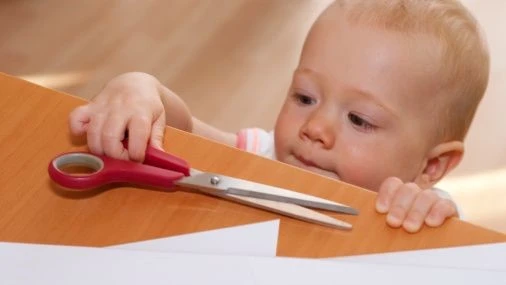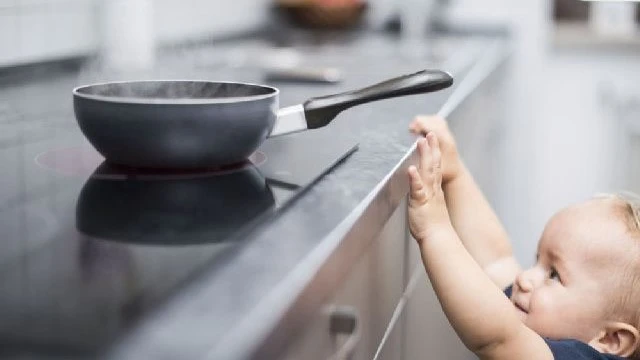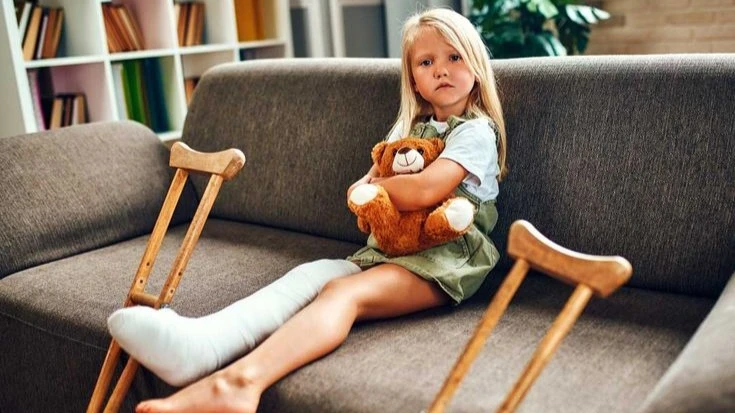“It only takes a second for a fall to happen—but a lifetime to deal with the consequences.” That’s what my grandmother always said, and now that I’ve had kids of my own, I get it.
The truth is, childhood injuries are way more common than most people think.
This blog isn’t a lecture. We’re going to walk through the most common childhood injuries, and I’ll show you the exact steps I took to prevent them (after I learned the hard way, honestly—about the most common childhood injuries and what you can do to prevent them.
From cuts and head bumps to bug bites and eye pokes, we’re diving deep. It’s simple stuff, but it makes a huge difference.
Top 10 Most Common Childhood Injuries (By Type)
Alright, so let’s break this down. The most common childhood injuries I’ve seen (and unfortunately dealt with) usually fall into a few categories. I’ve patched up scraped knees, iced bruised foreheads, and even rushed to urgent care after a fall from a treehouse. Not fun.
1. Falls
Kids fall from beds, bikes, playground equipment—you name it. One time, my youngest slipped on a wet bathroom tile and hit his chin so hard, he needed stitches. That moment really made me double-check every slippery surface in the house.
Prevention: Use anti-slip mats, install handrails on stairs, supervise climbing, and avoid furniture near windows. Secure furniture to walls to avoid tipping.
2.Cuts and scrapes
Kitchen knives, broken glass, even sharp toy edges—kids find ways to get hurt. Keeping sharp stuff out of reach and supervising arts and crafts has saved us a few ER visits.Even paper edges can lead to unexpected nicks, and rusted objects? They’re just tetanus waiting to happen. I’ve learned to keep bandages, antiseptic cream, and a calm head ready at all times. Keeping things tidy and checking toys for sharp edges can save a lot of tears.
Prevention: Keep sharp tools in locked drawers, monitor playtime with scissors or craft items, and clear away any broken items right away.

3. Burns
Hot drinks, stovetops, and curling irons are all danger zones. I once left a cup of tea on the table, and my daughter tipped it right onto her lap. A second of distraction and boom—burns.
Prevention: Keep hot liquids out of reach, turn pot handles inward on stoves, never leave kids unattended in the kitchen, and test bath water temperature before use.
Kitchen-related burns are a significant risk. Implementing safe cooking practices, such as those discussed in our Easy Toddler Meal Prep Ideas, can help minimize hazards.

4.Choking
Grapes, small toys, coins—anything can become a choking hazard. I cut food into tiny pieces and watch my kids like a hawk when they eat.
Choking can happen silently and within seconds, especially with toddlers. I’ve seen a child choke on a piece of hot dog at a family BBQ—it was terrifying. Ever since then, I stay close during snack time and never let them run around while eating.
Prevention: Cut food into small, safe-to-swallow pieces, avoid giving nuts or popcorn to toddlers, and keep small objects away from reach. Learn first aid for choking.
5.Insect bites and animal bites
We had a scare with a wasp sting that led to swelling and a mild allergic reaction. Keeping insect repellent handy and teaching kids to steer clear of unknown animals helps a ton.
Some bites might just cause itching, but others can trigger allergic reactions or infections. My neighbor’s kid got scratched by a stray cat and needed a tetanus shot—yikes. Now I always double-check for bugs before sending the kids out to play.
According to the American Veterinary Medical Association, kids actually make up about half of the 4.5 million annual animal bite cases in the U.S.—and most of those bites are from animals they already know. Kids and animals are both unpredictable, so don’t leave young children alone with an animal – even if the animal has always been friendly.
Prevention: Apply kid-safe insect repellent before outdoor play, wear protective clothing, and teach children not to pet unfamiliar animals. Keep play areas clean and garbage sealed.
6.Head injuries
Head injuries can range from mild bumps to serious concussions, and they’re not always obvious at first. Sometimes a kid seems fine, but symptoms like nausea or confusion show up later. That’s why it’s so important to monitor closely after any knock to the head.
My son once tripped over a backpack strap and slammed his head into the floor. He cried, I panicked.
Prevention: Always clear play areas, use helmets during bike or scooter rides, and supervise rough play closely. Use corner guards on furniture.
7. Eye injuries
Eye injuries can come from toys, fingernails, or even windblown sand. A minor scratch can cause major discomfort, and rubbing the eye only makes it worse. Trust me, it’s one of those injuries that’s easy to overlook until it’s too late.
Once, my daughter jabbed her eye with a pencil while coloring on the couch. That’s when I started enforcing table-only coloring time.
Prevention: Keep sharp objects out of reach, provide rounded-tip art supplies, and discourage running while holding objects.
8. Sprains and fractures
Playground missteps and scooter tricks gone wrong are the top culprits here.
sprain might just seem like a sore ankle, but it can sideline your kid for weeks if ignored. Fractures are even trickier—sometimes there’s no swelling but still a break hiding underneath. We’ve learned to err on the side of caution and get it checked if something seems off.
Prevention: Encourage proper use of equipment, supervise active play, and ensure your child warms up before sports.
Enhancing your toddler’s motor skills can reduce the risk of sprains. Our 15 Easy Fine Motor Skills Activities offer fun ways to build strength and coordination.

9.Poisoning
Poisoning can happen in seconds and often involves items we don’t even think are dangerous—like vitamins, soap, or plant leaves. Even a colorful detergent pod can look like candy to a curious toddler. I once caught my son trying to sip bubble solution. It’s scary how easy it is to overlook something until it’s too late.
Prevention: Store medicines, cleaners, and chemicals in locked cabinets. Use childproof containers and teach children about harmful substances.
10. Drowning
Drowning doesn’t just happen in pools—bathtubs, buckets, and even toilets can pose a threat. When my nephew slipped into an inflatable pool while no one was looking, it was a horrifying wake-up call. Luckily, we got to him in time, but I’ve never looked at water the same way since.
Prevention: Never leave kids unsupervised near any body of water, even shallow ones. Use pool gates, drain buckets, and always keep bathtubs empty when not in use.
These most common childhood injuries really hit home once you experience them. Prevention is all about being proactive—and realistic. You can’t bubble-wrap your kids, but you can absolutely create a safer space for them to explore.
Unintentional injuries are sadly the number one cause of death in kids ages 1 to 14.While that fact might surprise some people, specialists at UT Southwestern Pediatric Surgery treat hundreds of kids for everything from burns and poisonings to gunshot wounds and playground falls. Many of these injuries could have been avoided with safety reminders and precautions.
Age-Specific Injury Risks & Prevention
Injuries change as kids grow. When my kids were babies, I was more worried about choking and falling off changing tables. Now that they’re in school, it’s more about playground accidents and sports injuries. Each age comes with its own set of risks. And no matter the age, most common childhood injuries seem to follow them around.
For Infants
Infants are fragile little humans. Their heads are heavy, their necks are wobbly, and they explore everything with their mouths. Suffocation, choking, and falls are huge dangers here. I learned quickly to never leave my baby alone on the couch, even for a second.
For Toddlers
Toddlers are like tiny daredevils. Mine climbed everything—cabinets, couches, even the kitchen counter. I had to install baby gates, corner guards, and secure every piece of furniture to the wall. Poisoning risks are high here too. Keep meds and cleaners locked up tight.
For Preschoolers
Preschoolers are curious and mobile. They’ll run, jump, and tumble their way through the day. I focused on soft play areas, child-safe scissors, and teaching them basic safety rules like “don’t run with things in your mouth.”
For School-Age Children
By school age, injuries shift. Now it’s sports, biking, and roughhousing. My oldest broke his wrist falling off his scooter—because he wasn’t wearing wrist guards. Lesson learned. Helmets, pads, and clear safety rules are non-negotiable now.
In each stage, prevention starts with understanding what risks are most likely and acting accordingly. Childproofing isn’t just for babies. It evolves as they grow.
Psychological and Emotional Impact of Injuries
We often talk about the physical part of injuries, but let’s be real—getting hurt messes with kids emotionally too. My daughter got a deep cut on her leg once, and even after it healed, she was scared to go near the park where it happened. Trauma sticks.The emotional side of the most common childhood injuries is just as important to address.
I’ve learned to talk to my kids after every injury, even the minor ones. I let them tell me what happened, how they felt, and what scared them. Sometimes, it helps to just listen. One quote I love: “Children who are heard are children who heal.”
Not every kid bounces back right away. I noticed my youngest got extra clingy after falling down the stairs. We took it slow, gave him time, and eventually, he started going down the stairs on his own again—carefully this time.
If a child seems withdrawn, anxious, or scared long after an injury, don’t brush it off. Therapy or even a school counselor can help. Injuries affect their sense of safety and confidence. And that’s just as important as physical healing.
Sometimes, us parents get rattled too. That’s okay. Just don’t let your fear hold them back from being kids.
Latest Injury Stats and Trends in 2025
Here’s what’s wild—according to 2025 reports, falls still top the list of most common childhood injuries. But tech-related injuries are catching up. Yep, tablets and phones are tripping kids, causing eye strain, and even minor head injuries.
Playground injuries have also risen due to poorly maintained equipment. And did you know bike injuries make up nearly 15% of ER visits for school-aged children?
Burns, sprains, and eye injuries are still super common. Kids poke themselves with pencils or trip while texting. It’s a new age of accidents.
Data matters. It helps us prepare better. But nothing beats paying attention to your kid and how they play, move, and explore.
Tools, Products & Resources for Injury Prevention
Let me share some stuff that’s worked for us. We use these tools daily to help avoid the most common childhood injuries and keep peace of mind.
- Door alarms to alert when little ones try to sneak outside.
- Outlet covers and drawer locks in every room.
- Helmets and pads for biking, scootering, and skating.
- A stocked first-aid kit that I update every few months.
- A safety app that lets me track recalls on toys and baby gear.
We also follow the CDC child injury data page and signed up for email alerts from safety gear companies. Knowledge really is power here.
When to Seek Medical Attention Immediately
Some stuff you can handle at home. Others? Don’t wait. I’ve learned this from dealing with many of the most common childhood injuries—when in doubt, check it out.
Call the doctor or go to urgent care if:
- Your kid has a head injury and acts sleepy or confused.
- There’s bleeding that won’t stop after 10 minutes.
- You see a bone where it shouldn’t be.
- They’ve swallowed something dangerous.
- There’s a burn bigger than your hand.
You don’t wanna be that parent who waits too long. I’ve been there—once waited overnight for what turned out to be a fractured collarbone. Lesson learned.
Conclusion
Look, kids are gonna get hurt. It’s part of growing up. But knowing the most common childhood injuries, and having a plan to prevent them? That’s what makes the difference.
I’ve learned most of this stuff the hard way. But if this blog helps even one other parent avoid a trip to the ER, it’s worth it. Share it, save it, and use it to keep your home safer.
Let’s protect our little daredevils while still letting them be kids. And hey—if you’ve got a great safety hack or lesson learned the hard way, drop it in the comments. We’re all in this together!









